The big reveal is this: I’ve got Joe’s Boomershoot steel with me at school.
It seems that while the steel was loaned out a while back, someone either didn’t think or didn’t care or didn’t know that they had some old Soviet era steel core 7.62×39 ammo and decided that shooting it at his rather expensive AR500 steel plates was a good idea.
Quick review of steel grades. AR 500 is so called because it is “Abrasion Resistant”. It resists abrasion because it is harder than your average hot-rolled grade of mild steel. Think of case hardening, except that instead of being hard only on the shallow treated surface, it is harder all the way through. This makes it brittle and less ductile, and impacts do not deform the steel in the usual way and instead blast craters out of it.
Like this (click to enlarge, of course)
And like this
Now, you can fix these pot marks. And you want to. Letting further impacts happen in these craters will do the metal no good and will, eventually, after many repeated impacts, weaken your steel to the point where it is unsafe to shoot it from under 25-30ft because of shrapnel likely coming back at you. Yes, even with pistol rounds.
I spoke to Joe and Gene at Boomershoot and made mention of the program I’m in at school. I offered to make repairs to their steel targets and stands. Not only because I’m a nice guy, but also because I wanted an up close and personal look at the targets so as to give me ideas on what I’d like to make for other folks in the not too distant future.
Gene already had a repair guy lined up, but Joe said he’d be down with letting me fiddle about under the tutelage of my instructor at school. I took delivery and them made the haul into the Fab Shop.
Only slightly coincidentally, my current afternoon class is Metallurgy. We’re learning about metals and filler metals and heat treatment and annealing and all sorts of other down the rabbit hole information about metals and their properties. My instructor, upon learning that I was a gunnie asked if I had any plans to make shooting plates in class. I gave him a rather enthusiastic affirmative and he seemed quite pleased.
When I told him about possibly making some repairs on some AR500 repairs before Boomershoot, he gave me an enthusiastic affirmative. What can I say, the guy gets excited about metals. He lets himself get drug around to garage sales and swap meets by his wife and looks for wrought iron to play with. That, and he knows that I am trying to learn as much as I can in the short amount of time I have in the course. This knowledge will be useful to me in the future and learning from an expert is the best way to go about it.
Open up the link below for more on this
First of all, I had to remove the paint. All of it. And there was a lot of it. Dozens, if not hundreds, of coats of spray paint. Welding through paint is a sure way to turn good steel into bad. Two grinding wheels later
The wheels didn’t wear out. They filled up and refused to to anything up smear the paint.
Then it was time to get the paint that was applied after the damage that had piled up in the craters.
Before
And after
There were even some nasty edge hits.
Next, a little preheat with an OxyAcetylene rig, getting it up to temperature. About 500-600 degrees lets the crystalline structure of the metal relax just a bit so it will accept some filler metal.
Then you whack it in, keeping the temperature of the entire piece in the 500-600 degree range and maintaining it for the duration of the repair. Because you’re laying down beads of filler steel at 6000 degrees in one area while trying to keep the rest of these very large pieces of steel within the temp range, it takes at least two people and does not allow time for photos.
You also have to keep it warm after you are done laying down the beads. If you let it cool too rapidly the crystalline structure will warp and the hardness will fade. We would wrap one area while heating another and then switch, again and again. In the three hours of the class I had on Tuesday, we managed to get one mostly done. I still have to grind some spots flush with the original surface tonight and I hope to have pics of the final product up this weekend.

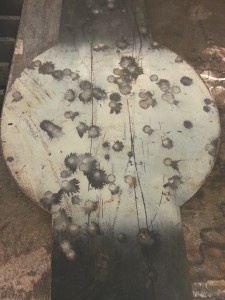
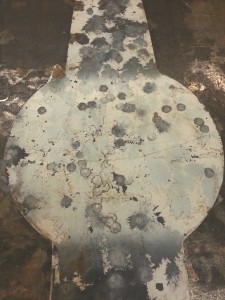
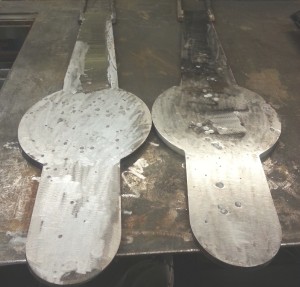
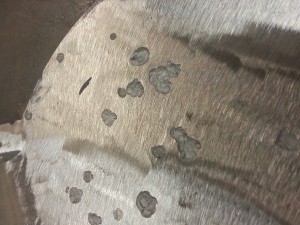
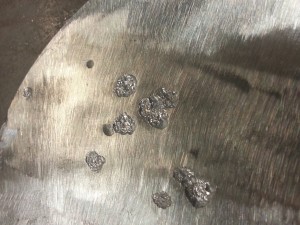
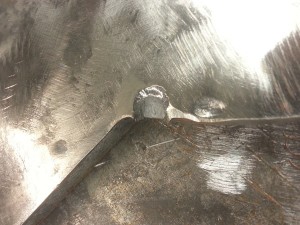
“Two grinding wheels later”
No sandblaster? Or would that cause more problems?
I know this is an educational project, but in real life would repairs like this be cheaper than just making new plates? Sounds pretty time/labor/energy intensive.
Interesting!
I wonder if you could use a forge to get the heating done and use a chemical stripper on the paint? Might save an awful lot of elbow grease and oxy set gas.
I also thought those edge hits would not be on hardened metal anyway since when the plates are cut out the hardening is ruined by the cutting operation?
Guy, about the only problems with a sandblaster would be finding one large enough (these are 5ft long), or the mess of blasting them outside of a box.
As for cost, these are made from 3/4in AR500 steel and likely cost more than $500 each. If it were just about anyone besides Joe or a few close other friends, I’d be charging around $100 for each one. I guess it depends on what value the steel owner puts on his steel.
DC, I’d be willing to try the chemical stripper. Provided it wasn’t too harmful to me. And you are correct about the edge hits and the loss of hardening along the edges. The heat affected zone is probably less than 1/8in though, so the boolit does have to hit in just the right spot to leave damage.
I was told they were water cut (no HAZ)
“The wheels didn’t wear out. They filled up and refused to to anything up smear the paint.”
Wouldn’t a stiff wire-cup have been more effective for the bulk of the paint removal? (he asks, not knowing what *kind* of paint was one there)
For an idea of the difference between Ar500 and real steel armor plate, I have a piece of armor that I personally shot for a demo-test with five rds of .223 ball, five rds of .223 AP, five rds of 7.62X39 ball and mild steel core(total 10 rds), and five rds of 7.62X51 standard ball. All five-shot groups had to be with a five-inch square, corner to corner. Distance was 50 feet. Plate was 6mm. The 7.62X51 ended up being 8 rds in a group that was about three inches across. The only damage to the plate after all shots were fire was that the paint was removed where the projectiles had hit. No visible deformation on the back of the palte. We sell this tuff to local leo for car doors and also to the US military. I’m told that at 8mm it will stop 7.62X 51 AP cold and 12mm will stop 50BMG at 50 yds. Going to try that on the 6mm just for grins when I get a chance, heh. The 6mm weighs about eight pounds/sf. The down side is it isn’t as cheap as the AR500.
If you want a real trip, there’s a place down here that plasma sprays large mining drills with some weird mix. We had a couple of 5/16″ hot-rolled plates done with it to a height of about a 1/4 inch and the damn stuff just laughed at standard ball at about 30 feet. Shot a whole belt of 100 rds from an RPK and all we did was wound one of our guys when a piece of shrapnel came back and hit him, heh, heh.
How much does AR500 and “proper” armor place cost, per lb or per sq ft in the 3/8 inch range?
IIRC the 6mm was about $250/sf. You can get AR500 – which is good stuff for what it does – for about $100/sf, I believe.
I too would like a sample of that armor.
AR500, locally mind you, was about $450 for a 4’x5′ piece of 3/8″ thickness. After the governor’s cut, about $25 per sqft.
You’re correct, my bad. I suspect I was thinking of something else. In any event that’s another BIG diffence between the steels. I’ll check with my people on Monday and get an actual cost on their stuff – but I am reasonably certain on that one.